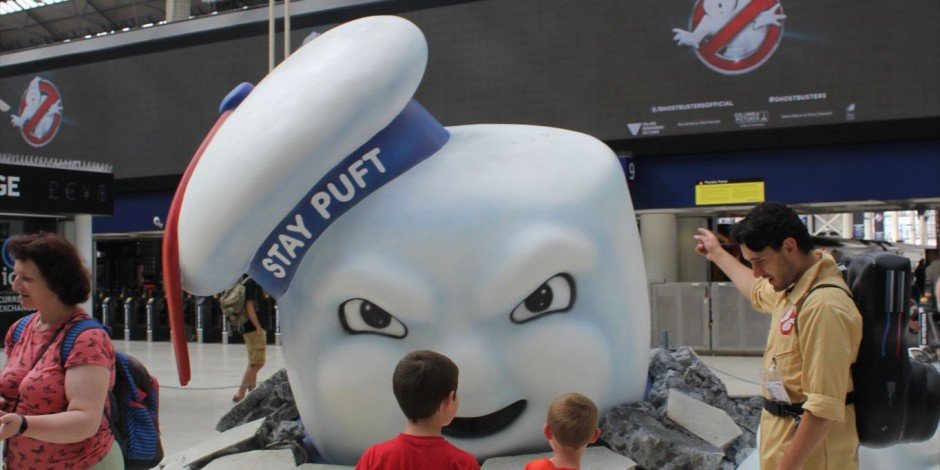Marketing will always be marketing, and we will always do it. Experiential marketing can be a fun and ultimately, memorable way of immersing your consumers into your brand’s world. If you’re confident with your product or service, a great experience will bring your audience in. If the service is good enough, they’ll stay.
Think back to 2016, when London’s Waterloo Station was overtaken by a Marshmallow Man, emerging through the concourse floor of the world-famous terminal – much to the amazement of passing by commuters. And what good was that? A big monster smashing through the floor; great for a selfie, but we all had trains to catch.
The stunt coincided with the launch of the new Ghostbusters movie, and it was a piece of brilliant advertising design, meant to be shared. Imagine a parent with a child walking through and taking a selfie with a giant Marshmallow man. What would the next step be? “You wanna see the movie?” Imagine a commuter walking through and sending a selfie to his or her partner… So many avenues opened by such a beautiful piece of experiential marketing. More than that, the piece inspired so much joy and created so many memories. Thousands of people were pleasantly surprised and shared their positive experience, hosted by the Ghostbusters brand.
Unexpected events create more pleasurable responses in the brain, so as marketers, we need to increasingly search for ways to ‘surprise’ and ‘delight’ consumers. And the Ghostbusters campaign certainly did that.
Take a look at Lush, the beauty stores popping up around the country. They, too, are adopting a similar strategy. Where else in the world can I go, as a husband, to buy my wife’s friend a birthday present, and be treated to an exfoliating hand wash that will leave me smelling like tea tree oil and blueberries? It’s attractive, it’s engrossing, it’s fun, and it makes us both want to go back and spend a bit more than we should. With so many average experiences available on the market, why not feel good about splashing out and spending a bit more… and ultimately, enjoy the feeling of being pampered?
Lush kept the essence of the brand in line with the experience they offered, accentuating what using its products feels like. So that users feel closer to their benefits by trying before they buy.
From a marketers’ point of view (or rather, the marketers’ bosses’ point of view), the role of experiential marketing is to capture the consumer and not slip into the abyss of complacency. A modern marketing plan includes a large number of disciplines, from digital efforts to the point of sale. And experience marketing has recently been added to this list.
How new is this, though? Think back to the Pepsi challenge – which is now almost 45 years old. It is fair to say that more than one company has followed this path of experience, aiming to create a similar lasting legacy. They need not be complicated; look again at what Lush do. Ask anybody who has recently visited a car showroom if there was an option to book a driving test. It’s always an experience that leads to a sale. Pepsi, Lush, Ghostbusters; they are all fantastic examples that share the same precept.
Social media, of course, now has its part to play in this. And its effect shouldn’t be ignored. Our obsession with finding something worthy to send to our network is the main reason that the marshmallow man, bursting through the floor, was so good.
Sharing through a swipe or a touch of a button is what marketers want. It means that their own users are doing the door-to-door sales for them, for free. They are digitally knocking on their friends’ doors and opening their suitcase of delights to show off your product. From the other side of the door, imagine that you are the metaphoric homeowner and ask yourself what you would prefer; a needy salesman trying to hit their commission, or your friend trying to show you something cool they just found. It’s a staggeringly good opportunity that can not be missed.
By encouraging and pandering to your consumer’s desire to share everything instantly, there are more ways to extend this experience to more people. You could attach a voucher to a marketing campaign and add a button directly linked to WhatsApp. That way, users can easily forward it on to friends or family who might also like the deal. The same can be done with a competition or mini-game format. Really, it’s up to marketers to find the outlets for their creativity.
Ironically, one aspect of the social media boom is its effect on elitism. It’s a fact that most people want to feel elite, yet more often than not, once they do feel this way, they’re likely to broadcast their new status online. Therefore, if a marketer were to offer them secret content, an exclusive event or a sneak peek, it’s possible that the ego-boosted recipient will, by virtue of the share button, wave their golden ticket in front of the world. The very fact that their exclusivity is nullified by doing so is seemingly ignored. And so the cycle continues.
Marketing agencies have endeavored to create moments for consumers that provide them with an experiential surprise. The user needs to feel pampered, valued, excited or elite. We must be innovative and unusual when creating shareable experiences.
If you’re ready to see what experiential marketing can do for you, do get in touch or visit our website for advice and help.
Jenny Stanley, Managing director at Appetite Creative.
This content was originally published here.



Leave A Comment